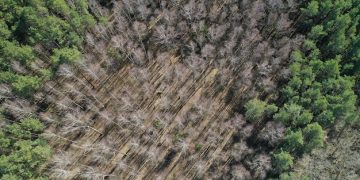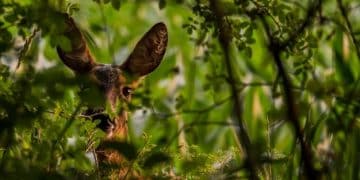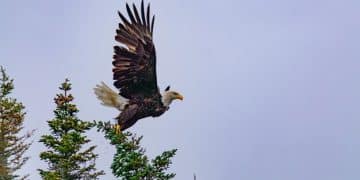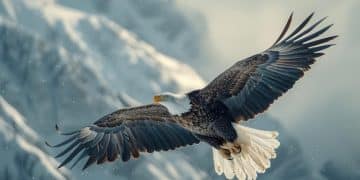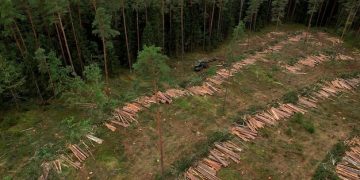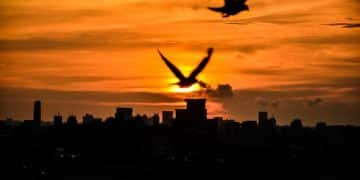Climate Change Impact on Wildlife: 5-Year Projections
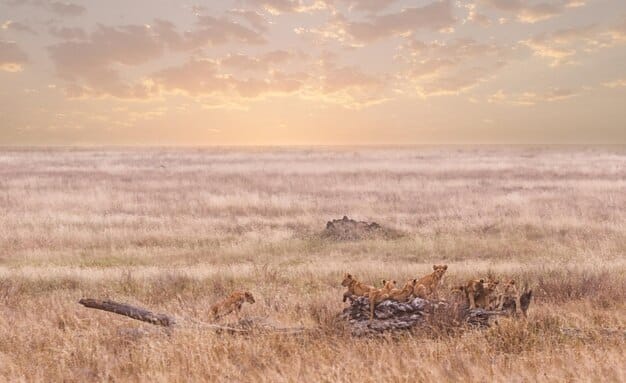
The impact of climate change on wildlife populations is projected to intensify over the next 5 years, leading to habitat loss, altered migration patterns, and increased extinction risks for various species, demanding urgent conservation efforts.
The natural world is facing unprecedented challenges. The impact of climate change on wildlife populations: what are the projections for the next 5 years? is a question that demands urgent attention, impacting ecosystems globally.
Understanding the Climate Change Threat to Wildlife
Climate change is no longer a distant threat; it’s a present reality that is acutely impacting wildlife populations across the globe. Rising temperatures, altered precipitation patterns, and increased frequency of extreme weather events are transforming habitats and disrupting the delicate balance of ecosystems.
For wildlife, these changes translate into a multitude of challenges, from habitat loss and food scarcity to increased vulnerability to disease and competition with invasive species. Understanding the multifaceted nature of this threat is the first step towards developing effective conservation strategies.
Habitat Loss and Fragmentation
One of the most significant consequences of climate change for wildlife is the loss and fragmentation of their habitats. As temperatures rise and precipitation patterns shift, ecosystems are forced to adapt or disappear, leaving wildlife with fewer places to live and breed.
For example, rising sea levels are inundating coastal wetlands and mangrove forests, vital habitats for numerous species of birds, fish, and invertebrates. Similarly, the melting of glaciers and ice sheets is reducing the extent of Arctic and alpine habitats, threatening iconic species such as polar bears and snow leopards.
Altered Migration Patterns
Many species of wildlife undertake long-distance migrations in search of food, breeding grounds, or more favorable climates. Climate change is disrupting these traditional migration patterns, forcing animals to embark on increasingly risky journeys.
Changes in temperature and precipitation can alter the timing and availability of food resources along migration routes, leaving animals with insufficient energy to complete their journeys. In addition, extreme weather events, such as droughts and floods, can create insurmountable obstacles, forcing animals to deviate from their established routes and exposing them to new dangers.
- Changes in temperature and precipitation disrupt food resources.
- Increasingly risky migrations contribute to species decline.
- Extreme weather events create insurmountable obstacles.
- Conservation efforts must adapt to altered migration patterns.
In conclusion, climate change poses a severe threat to wildlife populations by causing habitat loss and disrupting migration patterns, highlighting the urgent need for conservation efforts.
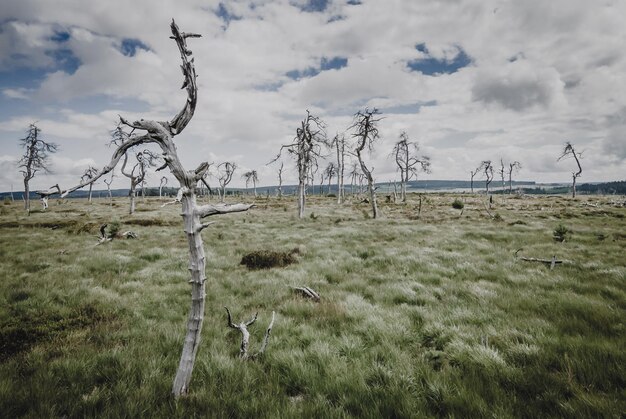
The Projected Impact on Key Species
Certain species are particularly vulnerable to the effects of climate change due to their specialized habitat requirements, limited dispersal abilities, or slow reproductive rates. Understanding the projected impact on these key species is crucial for prioritizing conservation efforts.
From marine mammals to amphibians and reptiles, a wide range of species are facing increased risks of extinction as a result of climate change. By studying their vulnerabilities and implementing targeted conservation measures, we can help to ensure their survival in a rapidly changing world.
Polar Bears
Polar bears are among the most iconic victims of climate change. As Arctic sea ice continues to melt, these magnificent predators are losing their primary hunting grounds, making it increasingly difficult for them to find food.
Studies have shown that polar bear populations are declining across the Arctic, and some experts predict that they could face extinction by the end of the century if current warming trends continue. Protecting polar bears requires urgent action to reduce greenhouse gas emissions and conserve their remaining habitat.
Coral Reefs
Coral reefs are among the most biodiverse ecosystems on Earth, providing habitat and food for a vast array of marine species. However, these delicate ecosystems are highly sensitive to changes in water temperature and acidity.
As ocean temperatures rise due to climate change, corals are experiencing increased rates of bleaching, a phenomenon in which they expel the symbiotic algae that provide them with food and color. Prolonged bleaching can lead to coral death and the collapse of entire reef ecosystems.
- Ocean acidification destroys coral reefs, threatening marine life.
- Rising temperatures cause coral bleaching and reef collapse.
- Marine ecosystems are vulnerable to subtle changes in climate.
- The loss of coral reefs disrupts the marine food chain.
In conclusion, key species like polar bears and coral reefs are highly vulnerable to climate change. Protecting these species requires immediate action to reduce greenhouse gas emissions and conserve their habitats.
Changes in Ecosystems and Food Chains
Climate change is not only affecting individual species but also disrupting entire ecosystems and food chains. These cascading effects can have far-reaching consequences for biodiversity and ecosystem function.
From changes in predator-prey relationships to shifts in plant communities, the impacts of climate change on ecosystems are complex and often unpredictable. Understanding these dynamics is essential for developing effective conservation strategies that address the root causes of biodiversity loss.
Altered Predator-Prey Dynamics
Climate change can alter the timing and location of food resources, forcing predators and prey to adapt their behavior. These changes can have significant consequences for population dynamics and ecosystem stability.
For example, changes in the timing of snowmelt can affect the availability of vegetation for herbivores, which in turn can impact the abundance and distribution of their predators. Similarly, changes in ocean currents can alter the distribution of fish stocks, affecting the foraging success of seabirds and marine mammals.
Shifts in Plant Communities
Climate change is causing shifts in plant communities across the globe. As temperatures rise and precipitation patterns change, some plant species are expanding their ranges while others are declining.
These changes in plant communities can have cascading effects on the animals that depend on them for food and shelter. For example, the loss of key forage species can lead to declines in herbivore populations, which in turn can affect the abundance and distribution of their predators.

In conclusion, climate change disrupts ecosystems and food chains by altering predator-prey dynamics and causing shifts in plant communities, highlighting the need for holistic conservation strategies.
The Role of Conservation Efforts
While the challenges posed by climate change are daunting, effective conservation efforts can make a significant difference in protecting wildlife populations. By implementing a range of strategies, from habitat restoration to climate adaptation, we can help wildlife to cope with the impacts of a changing climate.
These efforts involve collaboration across different sectors, including government agencies, non-profit organizations, and local communities. Together, these actors can develop innovative solutions that address the root causes of climate change and promote the long-term health of ecosystems.
Habitat Restoration
Restoring degraded habitats can provide wildlife with refuges from the impacts of climate change and enhance their resilience to future environmental changes.
This can involve planting native trees and vegetation, removing invasive species, restoring wetlands, and reconnecting fragmented habitats. By restoring these vital ecosystems, we can create more resilient landscapes that support a wide range of wildlife species.
Climate Adaptation Strategies
Climate adaptation strategies involve helping wildlife to adapt to the unavoidable impacts of climate change. This can include creating corridors that allow animals to move to more suitable habitats, providing supplemental food and water during times of scarcity, and vaccinating animals against emerging diseases.
By implementing these adaptive measures, we can help wildlife to persist in the face of a changing climate and minimize the risk of extinctions.
- Protect existing habitats.
- Restore degraded ecosystems.
- Implement climate adaptation strategies.
- Support research and monitoring efforts.
In conclusion, conservation efforts play a crucial role in protecting wildlife populations from climate change by restoring habitats and implementing adaptation strategies, fostering long-term ecosystem health.
Projections for the Next 5 Years
The projections for the next 5 years paint a concerning picture for wildlife populations. Unless significant action is taken to mitigate climate change, we can expect to see further declines in biodiversity, increased rates of extinction, and more frequent ecological disruptions.
However, these projections also offer an opportunity for action. By implementing ambitious climate policies, investing in conservation, and engaging local communities, we can bend the curve and create a more sustainable future for wildlife and people alike.
Increased Extinction Risks
The Intergovernmental Panel on Climate Change (IPCC) predicts that climate change will lead to increased extinction risks for many species of wildlife in the coming years. Species with limited ranges, specialized habitat requirements, or slow reproductive rates are particularly vulnerable.
The IPCC’s projections highlight the urgent need for conservation action to protect these vulnerable species and their habitats.
More Frequent Ecological Disruptions
Climate change is expected to increase the frequency and intensity of extreme weather events, such as droughts, floods, and heatwaves. These events can cause widespread ecological disruptions, leading to mass mortality events and long-term damage to ecosystems.
Preparing for and mitigating the impacts of these disruptions will be essential for protecting wildlife populations in the years ahead.
In conclusion, projections for the next 5 years indicate increased extinction risks and more frequent ecological disruptions due to climate change, stressing the urgency for immediate and comprehensive conservation actions.
Taking Action: What Can Be Done?
Addressing the impact of climate change on wildlife populations requires a collective effort from individuals, communities, and governments. By taking action at all levels, we can create a more sustainable future for wildlife and people alike.
From reducing our carbon footprint to supporting conservation organizations, there are many ways to make a difference. By working together, we can ensure that future generations have the opportunity to experience the wonder and beauty of the natural world.
Reduce Your Carbon Footprint
One of the most effective ways to reduce the impact of climate change on wildlife is to reduce your carbon footprint. This can involve making changes to your lifestyle, such as driving less, using public transportation, eating less meat, and conserving energy at home.
Every small action can make a difference, and by working together, we can create a significant impact.
Support Conservation Organizations
Supporting conservation organizations that are working to protect wildlife and their habitats is another important way to take action. These organizations are on the front lines of conservation, implementing innovative solutions to the challenges posed by climate change.
Donating your time or money to these organizations can help to ensure that they have the resources they need to continue their important work.
- Reduce your carbon footprint.
- Support conservation organizations.
- Advocate for climate policies.
- Educate others about climate change.
In conclusion, combating the impact of climate change on wildlife demands collective action from individuals, communities, and governments by reducing carbon footprints and supporting vital conservation efforts.
| Key Point | Brief Description |
|---|---|
| 🔥 Rising Temperatures | Increased temperatures disrupt habitats and migration patterns. |
| 🌊 Habitat Loss | Critical ecosystems are destroyed, reducing wildlife populations. |
| 🌍 Conservation Efforts | Restoring habitats and adapting to climate impacts can save species. |
| 🐾 Species Extinction | Numerous species face extinction within the next five years. |
FAQ
Climate change leads to habitat loss through rising temperatures, altered precipitation, and extreme weather. Coastal areas face inundation, while forests struggle with increased wildfires and droughts.
The primary threat is the loss of Arctic sea ice, crucial for hunting seals. As ice melts, polar bears struggle to find food, leading to malnutrition and population decline.
Rising ocean temperatures cause coral bleaching, where corals expel necessary algae. Ocean acidification also weakens coral structures, leading to reef degradation and loss of biodiversity.
Habitat restoration, climate adaptation strategies, and reducing carbon footprints are effectiveconservation efforts. Supporting organizations and advocating for policies also plays crucial roles.
Within the next five years, increased extinction risks and more frequent extreme weather events leading to extensive habitat disruption and population declines are expected to be seen.
Conclusion
The impact of climate change on wildlife populations: what are the projections for the next 5 years? presents a dire outlook, but also a call to action. By understanding these challenges and taking proactive steps, we can mitigate the effects and safeguard the world’s biodiversity for future generations.
